#amphibious assault ship
Text

"Recovery swimmer attaching the flotation collar around the Apollo 14 capsule (CM-110), with the still-attached parachute lines still visible."
Date: February 9, 1971
NASA ID: 71HC-245
#Apollo 14#Apollo CSM Block II#CSM-110#Kitty Hawk#NASA#Apollo Program#H-type mission#Splash down#Splashdown#Recovery#USS NEW ORLEANS (LPH-11)#USS NEW ORLEANS#Iwo Jima Class#Amphibious Assault Ship#Pacific Ocean#United States Navy#US#Navy#USN#February#1971#my post
81 notes
·
View notes
Text

USS Boxer (LPH-4, ex-CV-21) underway during exercise Steelpike I, in October 1964.
USS Boxer was one of the few Essex class carriers not modified with an angled deck after WWII. She was instead extensively modified to a Landing Platform Helicopter carrier in the late 1950s.
Photographed from USS Rigel (AF-58).
source
#USS Boxer (LPH-4)#USS Boxer (CV-21)#Essex Class#Boxer Class#Aircraft Carrier#amphibious assault ship#Vietnam War#warship#ship#boat#us navy#united states navy#navy#usn#u.s. navy#color photo#my post
41 notes
·
View notes
Photo
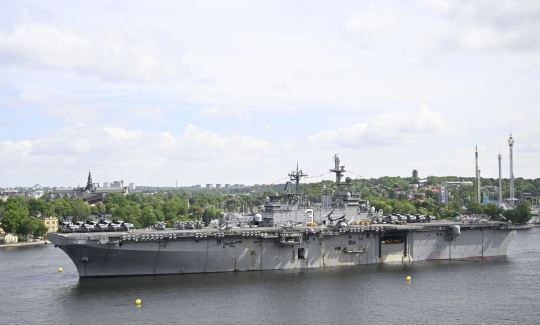
USS Kearsarge in Stockholm, Sweden, 2022. Source: https://www.seattletimes.com/nation-world/u-s-warship-arrives-in-stockholm-for-military-exercises-and-as-a-warning/
U.S. amphibious assault ship USS Kearsarge is seen in central Stockholm, Friday. Around 40 warships are expected to moor in Stockholm from June 2-5, ahead of the Baltops 22 exercise taking place June 5-17. (Henrik Montgomery / The Associated Press
#Sweden#Stockholm#USS Kearsarge#amphibious assault ship#ship#Baltic Sea#Northern Europe#defense of europe#defense of freedom#naval history#very good news#Baltops 22
2 notes
·
View notes
Text
youtube
#youtube#militarytraining#United States#US Navy#Technology#Military#Warships#Military Technology#Amphibious Warfare#US Military#Navy#Amphibious Assault Ships#Marines#US Marines#Amphibious Assault#Defense#Weapons#US Navy Technology#US Navy Ships#US Navy Marines#US Navy Warships#Navy Ships
0 notes
Text
#4DModel #type075lhd #type075amphibiousassaultship #yushenclass #modelship #modelbuilding
instagram
#4D Model#type 075 LHD#Yushen Class#Landing Helocopter Dock#Type 075 Amphibious Assault Ship#model ship#model building#original content#Instagram
0 notes
Text

A V-22 Osprey aircraft from the "Thunder Chickens" of Marine Medium Tiltrotor Squadron 263 takes off from the multi-purpose amphibious assault ship USS Bataan. Bataan is conducting routine operations in the Atlantic Ocean. USNORTHCOM, AT SEA
07.08.2008
Photo by Petty Officer 3rd Class Patrick Gearhiser
149 notes
·
View notes
Text

The USS Iwo Jima (LHD 7) - A Vital Component of the Wasp Class, Standing Strong as an Amphibious Assault Ship
26 notes
·
View notes
Text
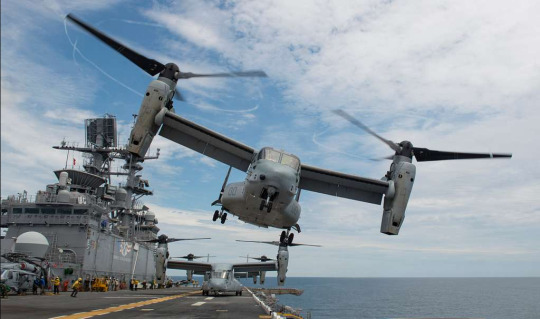
A USMC MV-22 lifting off the US Navy amphibious assault ship USS Iwo Jima in the Atlantic Ocean
47 notes
·
View notes
Text

U.S. Marines conduct weapons training aboard amphibious assault ship USS Bataan (LHD 5) in the Gulf of Aden, Aug. 11, 2023. Components of the Bataan Amphibious Ready Group and 26th Marine Expeditionary Unit are deployed to the U.S. 5th Fleet area of operations to help ensure maritime security and stability in the Middle East region.
(Photo by Sgt. Matthew Romonoyske-Bean)
55 notes
·
View notes
Text
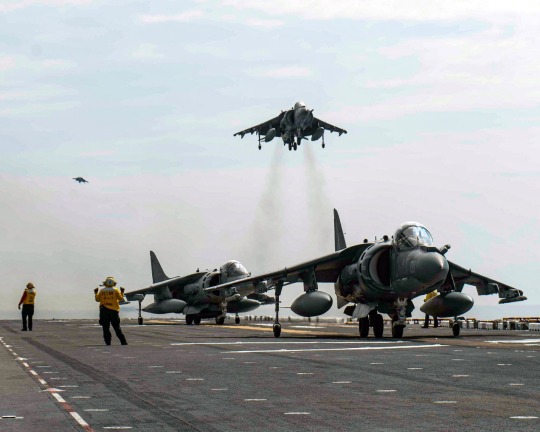
AV-8B Harriers, assigned to the “Tomcats” of Marine Attack Squadron (VMA) 311 on the amphibious assault ship USS Bonhomme Richard (LHD 6). June 2017. (mcssa Gavin Shields)
@kadonkey via X
46 notes
·
View notes
Text



"Apollo 14 crew members sit in a life raft beside their Command Module (CM-110) in the South Pacific Ocean as they await a U.S. Navy helicopter SH-3A Sea King from Anti-Submarine Squadron Six (HS-6), which will take them aboard the USS NEW ORLEANS (LPH-11), prime recovery ship. The crew men are, from left to right, astronauts Alan B. Shepard Jr., commander; Stuart A. Roosa, command module pilot; and Edgar D. Mitchell, lunar module pilot. Two U.S. Navy underwater demolition team swimmers (one partially visible in the right upper corner) assist in the recovery operations."
Date: February 9, 1971
Naval History and Heritage Command: USN 1146625
NASA ID: S71-19475
#Apollo 14#Apollo CSM Block II#CSM-110#Kitty Hawk#NASA#Apollo Program#H-type mission#Splash down#Splashdown#Recovery#USS NEW ORLEANS (LPH-11)#USS NEW ORLEANS#Iwo Jima Class#Amphibious Assault Ship#Pacific Ocean#United States Navy#US#Navy#USN#February#1971#Sikorsky SH-3 Sea King#SH-3#Helicopter#Helicopter Anti-Submarine Squadron Six#HS-6#my post
65 notes
·
View notes
Text
A Thing Of Vikings Chapter 110: A Unity Of View

Chapter 110: A Unity Of View
Bewilderbeast: Tidal-Class dragon
Overview: Amphibious-aquatic infrastructural/industrial dragon. In modern economies, they are helpful with construction of aquatic and submersible infrastructure and mining, as well as offering chemical and traditional refrigeration services. Militarily useful primarily in naval defense, as their speed is too slow to keep pace with a modern fleet, but are extremely useful for securing harbors and amphibious landing zones when called for.
Breath Type: Flash-Frozen water mixed with Ammonium Nitrate.
Identification: Medium to Gargantuan size. White, gray or black scales and hide, studded with large blunt spines along the back, neck, and tail, holding up a vestigial pair of wings along the lateral sides of the thorax. Four pillar-like legs. Two large tusks jut forward from the temples, aiding in water streamlining during swimming. Long tail with wide fin at terminal end, supported by more spikes. Overall teardrop body profile.
Strategic Role: Naval auxiliaries, submersible ship protection, mine-sweeping, submarine hunters, logistical support, construction support, amphibious assault support.
Known Weaknesses: Slow speed, semi-obligate aquatic, with larger individuals able to spend increasingly less time out of water without risk of harm. Modern mines and torpedoes can easily penetrate their hide in the absence of armor or countermeasures. Needs to breathe.
Phenotype Cluster: B5F3+SØSØSØT7+T5!
Populations: Moderate, but restricted to coastal and riverine regions, for obvious reasons.
—North Sea Empire, Office of Draconic Intelligence, Dragon Breed Profiles (Declassified), 1822 Edition
AO3 Chapter Link
~~~
My Original Fiction | Original Fiction Patreon
12 notes
·
View notes
Text

Marines Doing Jumping Jacks on Amphibious Assault Ship USS New Orleans, Aug. 1982
19 notes
·
View notes
Text
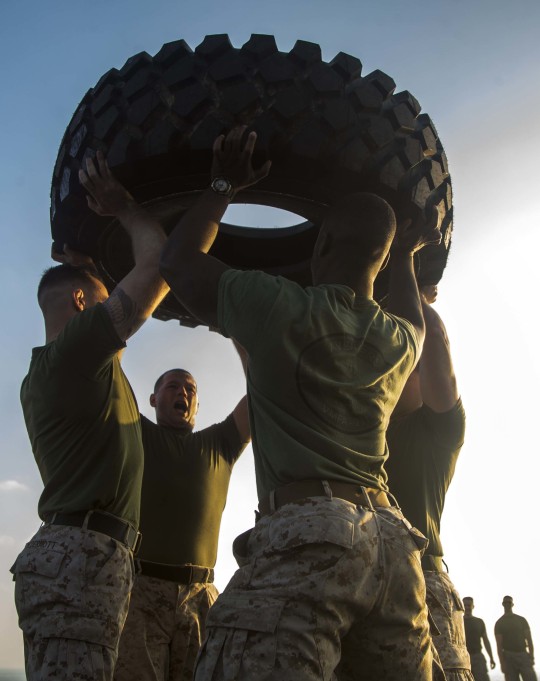
U.S. Marines during a squad competition aboard the Wasp-Class amphibious assault ship USS Essex (LHD 2).
The U.S. Marine Corps photo by Staff Sgt. Joshua Jackson (2018).
#army#military#us army#us military#armed forces#marines#us marines#military life#army strong#troops#veteran#soldier#marine#camouflage#camo#exercise#fitness#strong#military 1st
15 notes
·
View notes
Text

The Pentagon is deploying two carrier strike groups, eleven Burke-class destroyers, a number of Ticonderoga-class cruisers, amphibious assault ships, THAAD and Patriot missile defense systems, multiple squadrons of fighter jets, strategic bombers, and undisclosed assets to the Middle East.
The Pentagon expects Iranian proxies to continue to target U.S. troops in the region and has already stated that they will respond "decisively."
What's the probability that this escalates into a war between the United States and Iran?
PENTAGON: "Between October 17th and the 24th, U.S. and coalition forces have been attacked at least ten separate times in Iraq and three separate times in Syria via a mix of one-way attack drones and rockets...
We know that the groups conducting these attacks are supported by the IRGC and the Iranian regime. We are seeing the prospect for more significant escalation against U.S. forces and personnel across the region in the near term coming from Iranian proxy forces and, ultimately, from Iran.
So, by virtue of our announcement over the weekend, we are preparing for this escalation, both in terms of defending our forces and responding decisively."
27 notes
·
View notes
Text
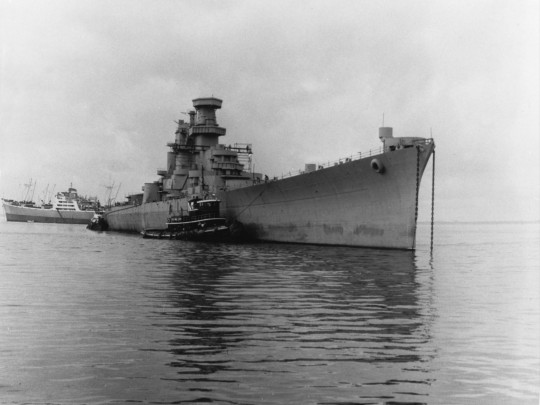

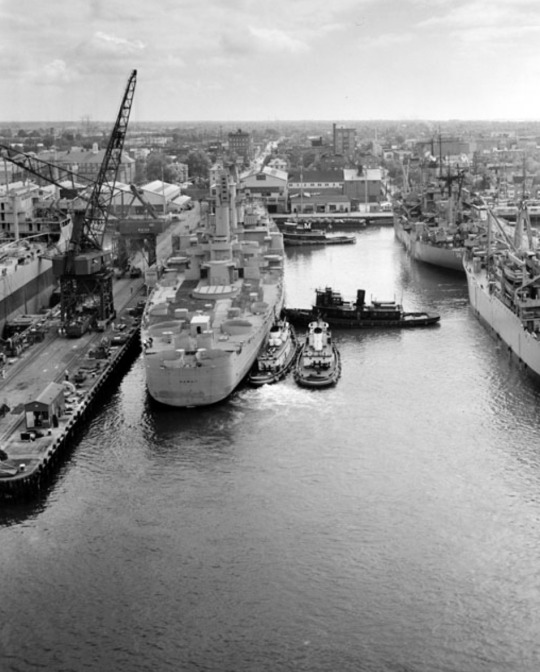
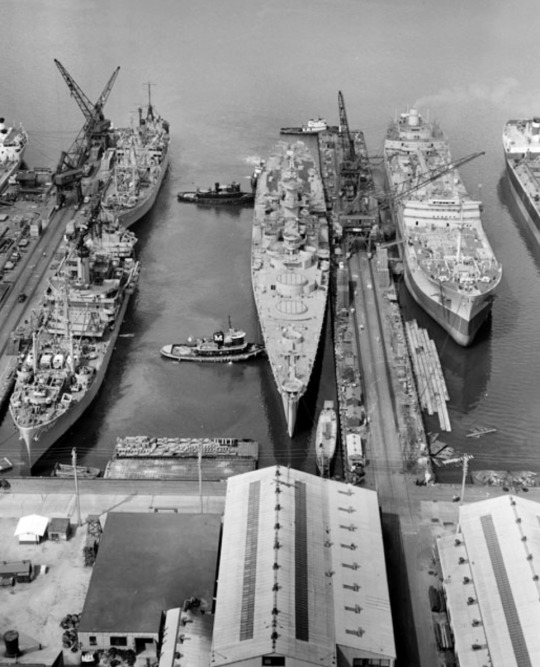


The incomplete HAWAII (CB-3) being moved to a berth, likely on her way to the scrapyard. Photographed on either May 20 or June 20, 1959. Likely the latter since the Navy Heritage and History Center has a better track record with dates.
Note: her 12 inch/50 caliber Mark 8 gun turrets have already been removed. They were removed in preparation for Hawaii would have become an Aircraft Carrier Task Force Command Ship, under SCB-83 and her hull designation changed to (CBC-1). Unlike the proposed ballistic and guided missile conversions, this conversion was budgeted in 1952.

Painting by Wayne Scarpaci
"This was as parallel to this program was a project to convert the unfinished Oregon City class heavy cruiser NORTHAMPTON (CLC-1) (later CC-1, ex-CA-125) to a National Emergency Command Post Afloat (NECPA). The NECPA program command ship (NORTHAMPTON) was where the US President and his Staff would direct US Military Forces during a nuclear conflict."
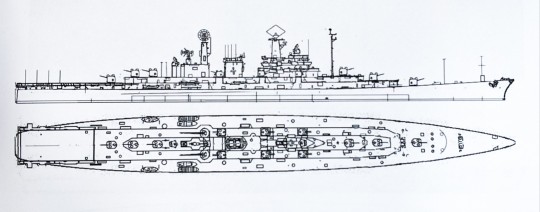
"Command and control of USN carrier forces during WWII was generally conducted from a standard vessel of the Task Force, with either a battleship or a carrier usually designated as flagship. But the presence of the force commander and his staff aboard was disruptive and resulted in overcrowded conditions, which impacted the combat effectiveness of the assigned ship. But with the superiority of the dedicated Amphibious Command Ship (AGC) concept for command and control of assault forces repeatedly demonstrated during WWII. Serious postwar consideration was given to the concept of a similar dedicated type of ship for Command and Control of Carrier Task Forces. In keeping with this concept in 1952 the USN developed the SCB-83 project to convert the HAWAII into a dedicated Carrier Task Force Command Cruiser (CBC-1). This design was strictly intended as a single mission ship featuring extensive flag facilities for command and control of carrier task forces, but no accommodations for amphibious or other types of operations.

The ship would have been armed with six 5 inch/54 caliber guns in single mounts, shipped three forward and three aft, with eight 3 inch/70 caliber guns in four enclosed twin mounts amidships. It would have fitted an AN/SPS2 radar atop a forward tower and an AN/SPS8A height finder on the aft superstructure. There was to be an SK-2 parabolic dish for tropospherical backscatter communications mounted atop short tower aft of the stack, forward of the AN/SPS8A. Two Mk37/directors with Mk25 fire control radars were provided on the superstructure fore and aft. The superstructure was built up amidships to accommodate the flag staff facilities and the single stack of the original CB design retained."
Work was halted after the turrets were removed and would continue after experience was gained from the conversion of NORTHAMPTON. However, it was discovered that it was easier and cheaper to convert USS WRIGHT (CVL-49) into the second Command ship without the loss of capability and HAWAII was sent back to the reserve fleet in Philadelphia Navy Yard.

The hull remained in the reserve fleet for 12 years before it was finally scrapped along with the incomplete hulls of KENTUCKY (BB-66) and ILLINOIS (BB-65).
U.S. Naval History and Heritage Command: NH 89293
Mariner's Museum and Park: P0001.014/01-#PN4850, P0001.014/01-#PN4858, P0001.014/01-#PN4853, P0001.014/01-#PN4847, P0001.014/01-#PN4848, P0001.014/01-#PN4849
Information, diagram and painting from "USN BATTESHIP CONVERSIONS PROJECTS" by Wayne Scarpaci: link
source
#USS HAWAII (CB-3)#USS HAWAII#Alaska Class#Large Cruiser#Battlecruiser#Cruiser#Warship#Ship#United States Navy#U.S. Navy#US Navy#USN#Navy#USS HAWAII (CBC-1)#Aircraft Carrier Task Force Command Ship#Command Ship#SCB-83#Cancelled#Philadelphia Navy Yard#Philadelphia#Pennsylvania#East Coast#Delaware River#scrapped#reserve#reserve fleet#May#June#1959#my post
45 notes
·
View notes